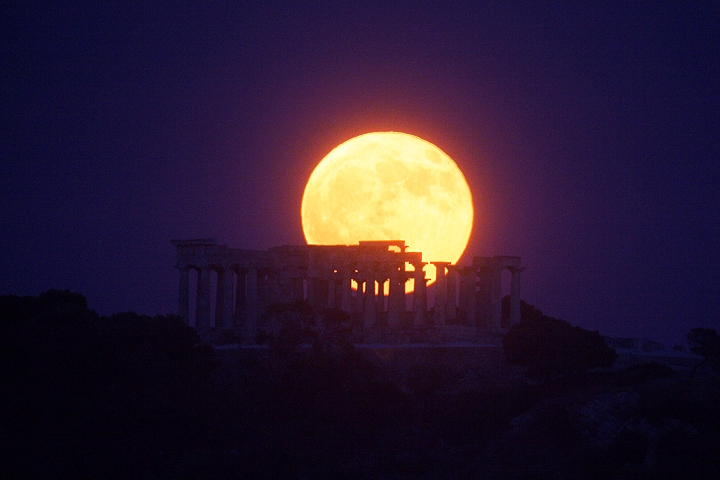
Our closest celestial neighbour has kept us company for at least four billion years and has entertained our imagination in a variety of
ways. It certainly has been involved in our maturation as a species with man's first step on a body beyond our planet during the latter
part of the twentienth century and will, inevitably, be our first stop prior to any sort of manned travel to a further celestial body
such as Mars. The moon has been a great source of education about our own planet's evolutionary history; it has entertained many
inquisitive minds from earlier cultures and generations about the universe in general and man's role in particular; it has enriched the
minds of young children taking their first look through a telescope and continues to impact our lives in ways we may or may not readily
recognize including tidal forces and various natural rhythms and cycles.
Note: The image below of the rising full moon against the Temple of Aphaia (490-480 BC) on the Saronic Gulf
island of Aegina south of mainland Greece is the latest effort involving the rising full moon against various archaeological grounds in Greece.
Following earlier efforts from 2004 and 2005 whose purpose was to identify the optimal time after sunset which would yield a perfect (!)
balance between the (bright) rising moon and the natural lighting of the Temple of Poseidon at Sounion Greece, determined to be approximately
22 minutes after sunset, the foundation had been laid for additional future work and similar results.
The photo below as well as two other photos from the same session (click
here and
here)
were taken from a distance of 1640 meters to the northwest of the temple and which provided the ideal location for these photos with respect
to aspect ratio, azimuth and altitude. The absence of lighting for the grounds at Aegina involving the Temple of Aphaia made the exercise
much more difficult than with the other archaeological grounds captured to-date and a repeat visit in 2009 will be required for a slightly
more natural optimal balance in lighting.
Note: For additional photos of the sun and/or full moon against other well-known Greek archaeological grounds and
sites, please click here.
|
Body: Moon Mass: 0.0123 x Earth Mean Eq Diameter: 0.2719 x Earth Distance: 397,414 km Sidereal Rev: 27d 07h 43m 11s Age: 15d 04h 00m Phase: 100.0° Diameter: 30.09' Magnitude: -12.6 Rukl: N/A |
 |
Date: July 18, 2008 Location: Isle of Aegina, Attiki, Greece Equipment: Takahashi FSQ 106/f5 Canon EOS 350D Exposure: 1 x 0.25 sec ISO 400 RAW Image Format 3456x2304 image size Manual Mode Software: Digital Photo Pro V1.6.1.0 Photoshop CS2 Processing: Resampling (24%) JPG Compression |